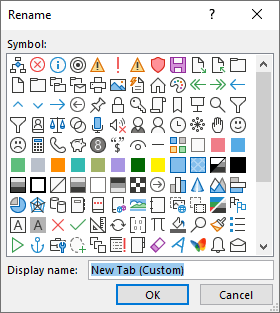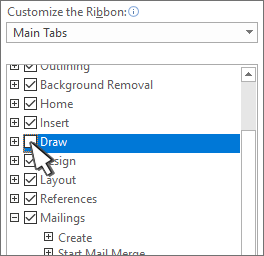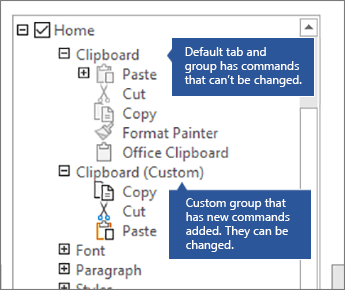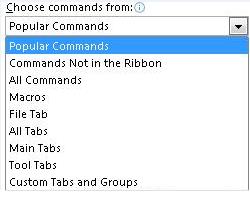What can you customize?
What you can customize: You can personalize your ribbon to arrange tabs and commands in the order you want them, hide or unhide your ribbon, and hide those commands you use less often. Also, you can export or import a customized ribbon.
What you can't customize: You can't reduce the size of your ribbon, or the size of the text or the icons on the ribbon. The only way to do this is to change your display resolution, which would change the size of everything on your page. You can't change the color of the ribbon or its icons, but you can change the color scheme that Office uses throughout. For more information, go to Change the look and feel of Microsoft 365.
When you customize your ribbon: Your customizations only apply to the Office program you're working in at the time. For example, if you personalize your ribbon in Word, those same changes won't be visible in Excel. If you want similar customizations in your other Office apps, you'll have to open each of those apps to make the same changes.
Hide or show your ribbon
-
Open Word.
-
To Hide the ribbon In the upper right corner of the app, select the ^.
To display the ribbon Select a tab. When the ribbon expands, select the
If you're using Read Mode, press the Esc key to display your ribbon.
Customize the ribbon
To open Customize the Ribbon and keyboard shortcuts window
-
Go to File > Options > Customize Ribbon.
Notes: To save time, you can do multiple additions and changes while the window is open and only save when you're done.
-
To save your changes and see the results, select OK in the customize window.
You can rename a default or custom tab or group. You can only rename commands that you've added to a custom group.
-
Select a tab, group, or command (custom groups only) to rename in the Customize the Ribbon window.
-
Select Rename, and then type a new name.
-
Optionally, you can also add an icon from the icon gallery.
-
In the Customize the Ribbon window, select the tab or group that you want to move.
-
Select the Move Up or Move Down arrow until you have the order you want.
You can hide both custom and default tabs. You cannot hide the File tab.
-
In the Customize the Ribbon window, clear the checkbox next to the default tab or custom tab that you want to hide.
Add or remove tabs or groups
You can add custom tabs or groups to put additional commands on the ribbon or replace default tabs with your own versions. Custom tabs and groups have (Custom) after the name in the Customize the Ribbon window, but the word (Custom) does not appear in the ribbon.
-
In the Customize the Ribbon window, select New Tab.
-
Right-click the new tab, select Rename, and type a new name or add an icon.
A custom group can be added to either a default or a custom tab.
-
Select the tab where you want the new group to appear.
-
Select New Group.
-
Right-click the new group, select Rename, and type a new name or add an icon.
You can't remove a default tab, but you can remove a custom tab.
-
Select the custom tab that you want to remove.
-
Select Remove.
You can remove either a default or custom group from a tab.
-
Select the default or custom group that you want to remove.
-
Select Remove.
You can't remove default commands from a group built into Word. However, you can hide a default group and make a custom group with the commands that you want to replace the default group.
-
In the Customize the Ribbon window, select the default tab where you want to add the custom group.
-
Select New Group.
-
Right-click the new group, and then select Rename.
-
Type a name for the new group and select an icon to represent the new group when the ribbon is resized.
-
In the Choose Commands from list, select Main Tabs.
-
Select the plus sign (+) next to the default tab that contains the group that you want to customize. (In some versions of Excel, you select a greater than sign (>) instead of a plus sign.)
-
Select the plus sign (+) next to the default group that you want to customize. (In some versions of Excel, you select a greater than sign (>) instead of a plus sign.)
-
Select the command that you want to add to the custom group, and then select Add >>.
-
Right-click the default group, and then select Remove.
Add, move, or remove commands from custom groups
To add commands to a group, you must first add a custom group to a default tab or to a new custom tab. Only commands added to custom groups can be renamed.
Default commands appear in gray text. You can't rename them, change their icons, or change their order.
You can only add, move, or remove commands in custom groups.
-
Select the custom group you want to add a command to.
-
In the Choose commands from list, select the list you want to add commands from. Examples: Popular Commands or All Commands.
-
Select a command from the Choose commands from window.
-
Select Add >>.
Note: You can also drag a command into to a custom group.
-
In the Customize the Ribbon window, select the command that you want to move.
-
Select the Move Up or Move Down arrow until you have the order you want.
You can only remove commands from a custom group.
-
In the Customize the Ribbon window, select the command that you want to remove.
-
Select Remove.
-
To see and save your changes, select OK.
Commands can only be renamed that you've added to a custom group.
-
In the Customize the Ribbon window, select the command that you want to rename.
-
Select Rename, and then type a new name.
-
Optionally, you can also add an icon from the icon gallery.
Show or hide command labels on a custom group
To hide the labels for the commands added to a custom group, right-click the group, and then select Hide Command Labels. Repeat to un-hide them.
You can reset all tabs to their original state or reset select tabs to their original state.
When you reset all tabs on the ribbon, you also reset the Quick Access Toolbar to show only the default commands.
Follow these steps to reset the ribbon:
-
In the Customize the Ribbon window, select Reset.
-
Select Reset all customizations.
You can only reset default tabs to their default settings.
-
In the Customize the Ribbon window, select the default tab that you want to reset to the default settings.
-
Select Reset, and then select Reset only selected Ribbon tab.
Share a customized ribbon with another user or another computer
You can save your ribbon and Quick Access Toolbar customizations into a file that can be imported and used by a coworker or on another computer.
-
In the Customize the Ribbon window, select Import/Export.
-
Select Export all customizations.
Important: When you import a ribbon customization file, you lose all prior ribbon and Quick Access Toolbar customizations. To later revert to the customization you currently have, you should export them before importing any new customizations.
-
In the Customize the Ribbon window, select Import/Export.
-
Select Import customization file.



















